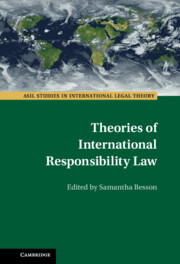Book contents
- Theories of International Responsibility Law
- ASIL Studies in International Legal Theory
- Theories of International Responsibility Law
- Copyright page
- Contents
- Contributors
- Preface
- Theorizing International Responsibility Law, an Introduction
- Part I International Responsibility of Public Institutions: Public and/or Private?
- 1 From ‘Respondere’ to ‘Responsibility’
- 2 Change in the Law of International Responsibility
- 3 State Responsibility
- 4 Responsibility of States for Wrongdoing
- Part II International Responsibility of Public Institutions: Collective and/or Individual?
- Part III International Responsibility of Public Institutions: Fault-based or Not?
- Part IV Responsibility of Public Institutions: A World Tour
- Index
2 - Change in the Law of International Responsibility
from Part I - International Responsibility of Public Institutions: Public and/or Private?
Published online by Cambridge University Press: 01 September 2022
- Theories of International Responsibility Law
- ASIL Studies in International Legal Theory
- Theories of International Responsibility Law
- Copyright page
- Contents
- Contributors
- Preface
- Theorizing International Responsibility Law, an Introduction
- Part I International Responsibility of Public Institutions: Public and/or Private?
- 1 From ‘Respondere’ to ‘Responsibility’
- 2 Change in the Law of International Responsibility
- 3 State Responsibility
- 4 Responsibility of States for Wrongdoing
- Part II International Responsibility of Public Institutions: Collective and/or Individual?
- Part III International Responsibility of Public Institutions: Fault-based or Not?
- Part IV Responsibility of Public Institutions: A World Tour
- Index
Summary
The law of responsibility has been subject to massive change over the past centuries. While in key areas such change is well-established in the form of customary law or general principles, for particular transformations the process of change is more difficult to pin down. Major examples are the transition from a private to a public law model and from independent to shared responsibility, where the depth and scope of change and its support in practice remains uncertain. The author argues that the normal rules for determination of change in international law, reflected in the sources of international law, are not always helpful for determining change in the law of responsibility. To understand such change, it is helpful to distinguish change in secondary rules from change in primary rules (substantive rights and obligations) and tertiary rules (procedures and institutional rules for implementing responsibility). Change in the law of responsibility is to some extent driven by prior changes in primary rules, but it is also argued that secondary rules have a logic and justification that is to some extent independent from primary rules.
Keywords
- Type
- Chapter
- Information
- Theories of International Responsibility Law , pp. 43 - 69Publisher: Cambridge University PressPrint publication year: 2022



